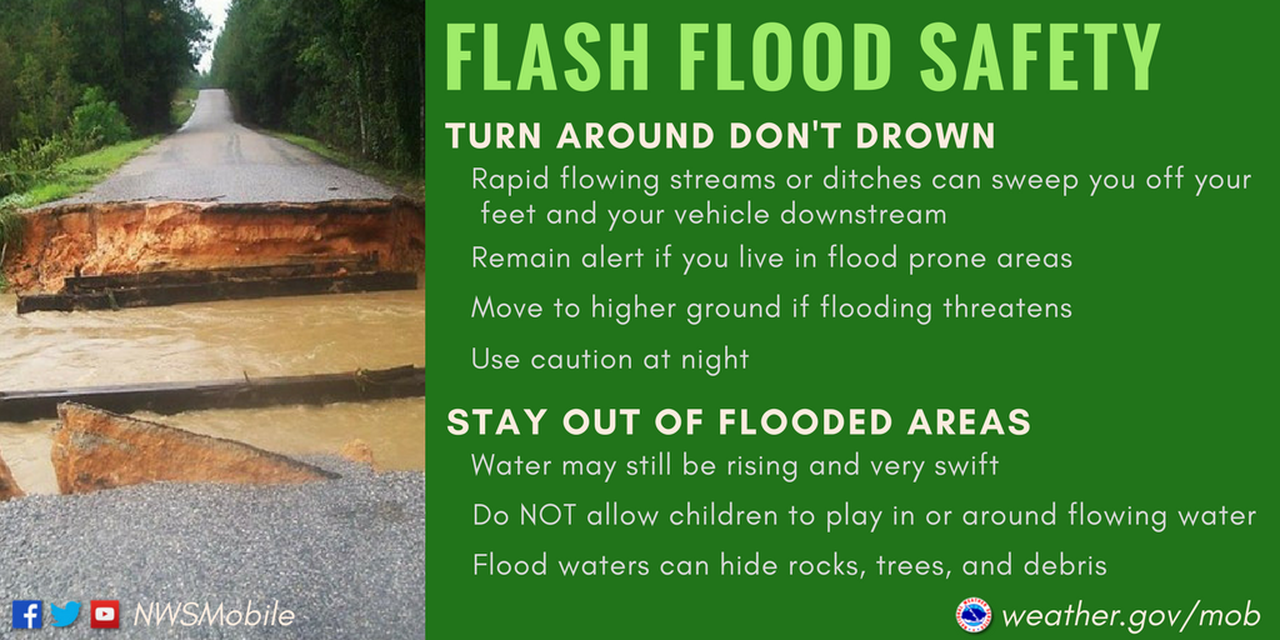Flash Floods: How To Prepare For And Respond To Flood Warnings

Table of Contents
Understanding Flash Flood Risks and Warnings
Identifying High-Risk Areas
Flash floods can occur almost anywhere, but certain geographical locations are particularly vulnerable. High-risk areas are often characterized by steep slopes, canyons, mountains, and deserts, where heavy rainfall can quickly overwhelm drainage systems. Other factors contributing to flash floods include dam failures, levee breaches, and sudden snowmelt. Identifying if you live in a flood-prone zone is the first step in effective preparedness.
- Examples of high-risk areas: Areas near rivers, streams, and canyons; mountainous regions; areas with poor drainage; urban areas with inadequate drainage infrastructure.
- Typical warning signs: Rapidly rising water levels in streams or rivers; overflowing streams, creeks, or rivers; unusual water flow in normally dry areas; reports of heavy rainfall in your area.
- Knowing your surroundings and the potential for flash flood triggers is paramount in minimizing risk. Understanding your location’s susceptibility to flash floods helps you prioritize preparedness measures.
Recognizing Warning Signs and Alerts
Staying informed is critical for surviving a flash flood. Various methods alert the public to impending danger. These include:
- National Weather Service (NWS) alerts: These are issued via television, radio, and mobile apps. Sign up for weather alerts specific to your location.
- Emergency sirens: These often indicate immediate danger and the need for immediate action. Understand local emergency protocols.
- Official announcements: Local authorities may issue warnings through various channels, including social media, community alerts, and public address systems.
Understanding the severity levels of warnings (e.g., watch vs. warning) is also important. A watch indicates conditions are favorable for a flash flood, while a warning means a flash flood is occurring or is imminent.
Preparing for a Flash Flood
Developing a Family Emergency Plan
A well-defined family emergency plan is vital. It should include:
- Communication plan: Establish a primary and secondary contact person outside the immediate area. Pre-determine communication methods (text messages, phone calls).
- Evacuation routes: Identify multiple escape routes from your home and neighborhood, considering potential road closures.
- Designated meeting place: Choose a safe meeting location outside the affected area.
Regularly practice your emergency plan with your family to ensure everyone is prepared and knows their roles.
Assembling an Emergency Kit
Having a dedicated flash flood emergency kit readily available is essential. This kit should contain:
- Water: At least one gallon of water per person per day for several days.
- Non-perishable food: Easy-to-prepare foods that require no cooking.
- First-aid kit: Including any necessary prescription medications.
- Flashlights and extra batteries: Important for navigating during power outages.
- Whistle: To signal for help.
- Important documents: Copies of insurance policies, identification, and medical records in a waterproof container.
Keep this kit in an easily accessible location and ensure everyone in the household knows where to find it.
Protecting Your Property
Taking preventative steps can significantly reduce the damage to your property:
- Elevate valuables: Move important belongings to higher levels of your home or to a safe location.
- Install flood barriers: Consider installing sandbags or flood barriers around your property to protect against rising waters.
- Clean gutters and drains: Regularly clean your gutters and downspouts to ensure proper drainage.
Regularly inspect your property for potential vulnerabilities and take steps to reinforce them before a flash flood occurs.
Responding to a Flash Flood Warning
Evacuating Safely
If a flash flood warning is issued, evacuate immediately.
- Heed official warnings: Don't delay; obey evacuation orders from authorities.
- Avoid flooded areas: Never attempt to drive or walk through flooded areas; the water may be deeper and faster than it appears.
- Take essential items: Bring your emergency kit, important documents, medications, and any irreplaceable personal items.
If you are unable to evacuate, move to the highest level of your home.
Seeking Shelter
If evacuation is not possible, seek shelter on the upper floors of a sturdy building or in a designated emergency shelter.
- Avoid basements: Basements are particularly vulnerable during flash floods.
- Stay away from power lines: Downed power lines pose a significant electrical hazard.
- Monitor conditions: Continuously monitor weather reports and official announcements for updates.
Post-Flood Actions
Once the flash flood subsides:
- Check for damage: Assess the damage to your home and property.
- Contact authorities: Report any damage to your local authorities and insurance company.
- Seek assistance: Contact FEMA or other relief organizations if needed.
Remember to take necessary safety precautions during post-flood cleanup to avoid hazards like contaminated water and structural damage.
Conclusion
Preparing for and responding to flash floods requires proactive planning and decisive action. Developing a comprehensive emergency plan, assembling an emergency kit, and staying informed about weather forecasts and warnings are critical steps. Don't wait for a flash flood to strike. Start preparing today by creating your family's flash flood emergency plan and assembling your essential supplies. Your proactive approach could save lives and protect your property from the devastating effects of flash floods. For more information and resources, visit the National Weather Service (weather.gov) and FEMA (fema.gov).

Featured Posts
-
 Delaware Governor On Fascism Addressing The Trump Era And Beyond
May 26, 2025
Delaware Governor On Fascism Addressing The Trump Era And Beyond
May 26, 2025 -
 Responding To A Flood Warning Essential Actions Based On Nws Advice
May 26, 2025
Responding To A Flood Warning Essential Actions Based On Nws Advice
May 26, 2025 -
 Moto Gp 2025 Analisis Klasemen Dan Peluang Marc Marquez
May 26, 2025
Moto Gp 2025 Analisis Klasemen Dan Peluang Marc Marquez
May 26, 2025 -
 Jenson And The Fw 22 Extended Fabrics Cuts And Finishes
May 26, 2025
Jenson And The Fw 22 Extended Fabrics Cuts And Finishes
May 26, 2025 -
 Tonton Balap Motor Moto Gp Inggris 2025 Sprint Race Secara Live Streaming
May 26, 2025
Tonton Balap Motor Moto Gp Inggris 2025 Sprint Race Secara Live Streaming
May 26, 2025
